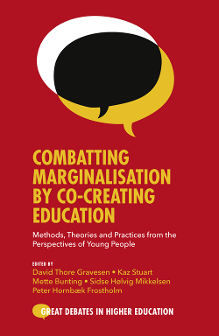
Index
Combatting Marginalisation by Co-creating Education
ISBN: 978-1-80043-451-6, eISBN: 978-1-80043-448-6
Publication date: 8 February 2021
Citation
(2021), "Index", Gravesen, D.T., Stuart, K., Bunting, M., Mikkelsen, S.H. and Frostholm, P.H. (Ed.) Combatting Marginalisation by Co-creating Education (Great Debates in Higher Education), Emerald Publishing Limited, Leeds, pp. 223-228. https://doi.org/10.1108/978-1-80043-448-620211019
Publisher
:Emerald Publishing Limited
Copyright © 2021 by Emerald Publishing Limited
INDEX
- Prelims
- Part 1 Background Discussions, Theoretical and Methodological Accounts
- 1 Bringing People Together: An Introduction to the Book, the Project and the Research Behind It
- 2 Socio-cultural Learning: Students as Co-researchers, a Key for Students' Success
- 3 The Context of Early School Leavers
- 4 Equalities Literacy Framework
- 5 The Indirect Approach – The Basics, the Craft and the Ethics
- Part 2 Empirical Findings, Narratives and Analytical Takes
- 6 The Importance of the Student–Teacher Relationship
- 7 The Educational Potential of the Arts for At-Risk students
- 8 Social Exclusion in School – A View on Vulnerability in a Context-based Perspective
- 9 The One and Only Civilised Way through Education
- 10 Young Voices about Inclusive Education
- 11 Educational Deprivation in Blackpool in the UK
- 12 ‘Done with’ Not ‘Done to’. Confronting Marginalisation by Engaging in Conversations with Young People
- 13 The Importance of Families and Social Relations Outside School
- Part 3 Implications and Potentials for Future Practice
- 14 A Broader View at Marginalisation – And the Steps Towards Change
- 15 Now What? Practical Implications for Higher Education
- 16 A Love Letter of Sorts
- Index